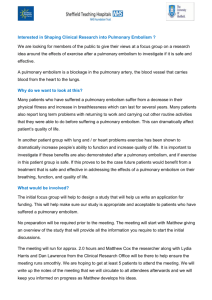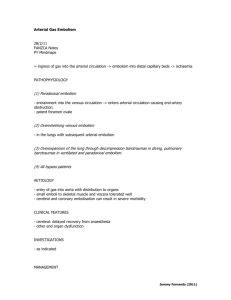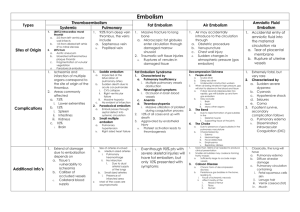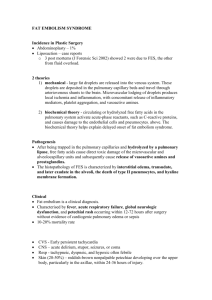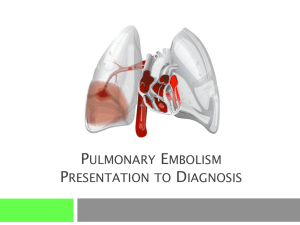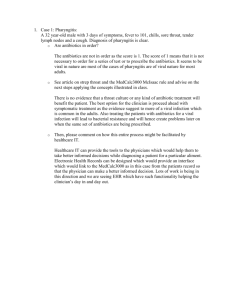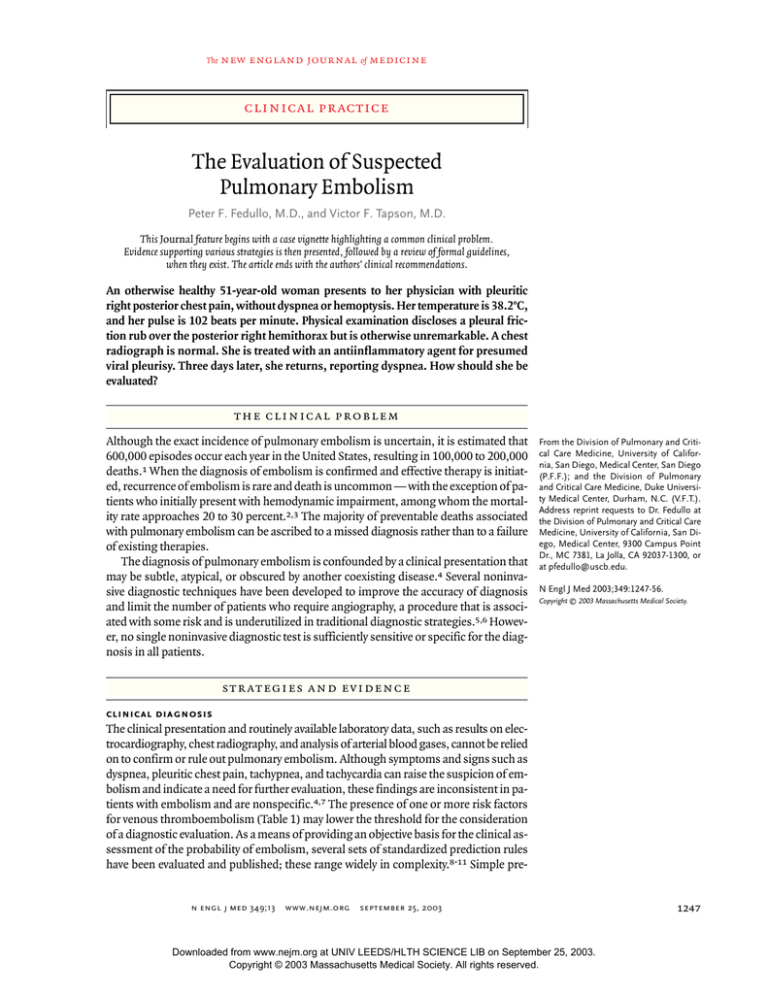
The
new england journal
of
medicine
clinical practice
The Evaluation of Suspected
Pulmonary Embolism
Peter F. Fedullo, M.D., and Victor F. Tapson, M.D.
This Journal feature begins with a case vignette highlighting a common clinical problem.
Evidence supporting various strategies is then presented, followed by a review of formal guidelines,
when they exist. The article ends with the authors’ clinical recommendations.
An otherwise healthy 51-year-old woman presents to her physician with pleuritic
right posterior chest pain, without dyspnea or hemoptysis. Her temperature is 38.2°C,
and her pulse is 102 beats per minute. Physical examination discloses a pleural friction rub over the posterior right hemithorax but is otherwise unremarkable. A chest
radiograph is normal. She is treated with an antiinflammatory agent for presumed
viral pleurisy. Three days later, she returns, reporting dyspnea. How should she be
evaluated?
the clinical problem
Although the exact incidence of pulmonary embolism is uncertain, it is estimated that
600,000 episodes occur each year in the United States, resulting in 100,000 to 200,000
deaths.1 When the diagnosis of embolism is confirmed and effective therapy is initiated, recurrence of embolism is rare and death is uncommon — with the exception of patients who initially present with hemodynamic impairment, among whom the mortality rate approaches 20 to 30 percent.2,3 The majority of preventable deaths associated
with pulmonary embolism can be ascribed to a missed diagnosis rather than to a failure
of existing therapies.
The diagnosis of pulmonary embolism is confounded by a clinical presentation that
may be subtle, atypical, or obscured by another coexisting disease.4 Several noninvasive diagnostic techniques have been developed to improve the accuracy of diagnosis
and limit the number of patients who require angiography, a procedure that is associated with some risk and is underutilized in traditional diagnostic strategies.5,6 However, no single noninvasive diagnostic test is sufficiently sensitive or specific for the diagnosis in all patients.
From the Division of Pulmonary and Critical Care Medicine, University of California, San Diego, Medical Center, San Diego
(P.F.F.); and the Division of Pulmonary
and Critical Care Medicine, Duke University Medical Center, Durham, N.C. (V.F.T.).
Address reprint requests to Dr. Fedullo at
the Division of Pulmonary and Critical Care
Medicine, University of California, San Diego, Medical Center, 9300 Campus Point
Dr., MC 7381, La Jolla, CA 92037-1300, or
at pfedullo@uscb.edu.
N Engl J Med 2003;349:1247-56.
Copyright © 2003 Massachusetts Medical Society.
strategies and evidence
clinical diagnosis
The clinical presentation and routinely available laboratory data, such as results on electrocardiography, chest radiography, and analysis of arterial blood gases, cannot be relied
on to confirm or rule out pulmonary embolism. Although symptoms and signs such as
dyspnea, pleuritic chest pain, tachypnea, and tachycardia can raise the suspicion of embolism and indicate a need for further evaluation, these findings are inconsistent in patients with embolism and are nonspecific.4,7 The presence of one or more risk factors
for venous thromboembolism (Table 1) may lower the threshold for the consideration
of a diagnostic evaluation. As a means of providing an objective basis for the clinical assessment of the probability of embolism, several sets of standardized prediction rules
have been evaluated and published; these range widely in complexity.8-11 Simple pre-
n engl j med 349;13
www.nejm.org
september 25, 2003
Downloaded from www.nejm.org at UNIV LEEDS/HLTH SCIENCE LIB on September 25, 2003.
Copyright © 2003 Massachusetts Medical Society. All rights reserved.
1247
The
new england journal
Table 1. Risk Factors for Venous Thromboembolism.
Age >40 yr
History of venous thromboembolism
Surgery requiring >30 min of anesthesia
Prolonged immobilization
Cerebrovascular accident
Congestive heart failure
Cancer
Fracture of pelvis, femur, or tibia
Obesity
Pregnancy or recent delivery
Estrogen therapy
Inflammatory bowel disease
Genetic or acquired thrombophilia
Antithrombin III deficiency
Protein C deficiency
Protein S deficiency
Prothrombin G20210A mutation
Factor V Leiden
Anticardiolipin antibody syndrome
Lupus anticoagulant
d -dimer testing
The measurement of the degradation products of
cross-linked fibrin (d-dimer) circulating in plasma
is a highly sensitive but nonspecific screening test
for suspected venous thromboembolism. Elevated
levels are present in nearly all patients with embolism but are also associated with many other circumstances, including advancing age, pregnancy, trauma, the postoperative period, inflammatory states,
and cancer.12 The role of d-dimer testing is therefore limited to the ruling out of embolism.
n engl j med 349;13
medicine
Multiple d-dimer assays have been developed,
with sensitivities that range from almost 100 percent to as low as 80 percent. Highly sensitive assays,
such as standard or rapid enzyme-linked immunosorbent assays, have high false positive rates but
safely rule out thromboembolism in outpatients
presenting with a low clinical probability of embolism.13-16 Less sensitive assays (e.g., latex agglutination or red-cell agglutination) cannot be used in
isolation to rule out thromboembolism. The generalized application of d-dimer testing has been limited by a burgeoning number of available assays and
a lack of standardization that has resulted in uncertainty among clinicians regarding the predictive
value of the particular assays available to them.
ventilation–perfusion scanning
diction rules (Table 2) involve information that can
be acquired easily in the outpatient setting or the
emergency room.9,10 More complicated prediction
rules involve a larger number of clinical variables
and require the interpretation of radiographic and
electrocardiographic data by experts.11
The use of empirical or standardized assessments of probability allows patients to be classified
into three groups on the basis of the approximate
prevalence of pulmonary embolism: low clinical
probability (a subgroup with a prevalence of 10 percent or less), intermediate clinical probability (a
prevalence of approximately 30 percent), and high
clinical probability (a prevalence of approximately
70 percent or higher).8-11 The combined use of the
estimated clinical probability and the results of one
or more noninvasive tests substantially increases
the accuracy in confirming or ruling out embolism,
as compared with either assessment alone.
1248
of
Ventilation–perfusion scanning has had a central
role in the diagnosis of embolism for almost three
decades and is a valuable tool when the results are
definitive.17 A normal ventilation–perfusion scan
essentially rules out the diagnosis of embolism, and
a scan deemed to indicate a high probability of embolism is strongly associated with the presence of
embolism. However, large trials have demonstrated
that most patients with suspected embolism who
undergo ventilation–perfusion scanning do not have
findings that are considered definitive. The majority of patients with embolism do not have findings
on scanning that indicate a high probability of embolism, and the overwhelming majority of patients
without embolism do not have normal findings
on scanning.7
computed tomography
The use of computed tomography (CT) has been a
major advance in the diagnosis of embolism. Unlike ventilation–perfusion scanning, it allows the
direct visualization of emboli as well as the detection of parenchymal abnormalities that may support the diagnosis of embolism or provide an alternative explanation for the patient’s symptoms. The
reported sensitivity of helical CT scanning for the
diagnosis of embolism ranges from 57 to 100 percent, and its reported specificity ranges from 78 to
100 percent.18,19 These wide ranges are explained
in part by differences in the technology used, since
newer scanners allow higher resolution, dramatically faster scanning times, better peripheral visualization, and less motion artifact than earlier-generation scanners. The sensitivity and specificity also
vary with the location of the emboli, ranging from
www.nejm.org
september 25 , 2003
Downloaded from www.nejm.org at UNIV LEEDS/HLTH SCIENCE LIB on September 25, 2003.
Copyright © 2003 Massachusetts Medical Society. All rights reserved.
clinical practice
90 percent (for both measures) for emboli involving the main and lobar pulmonary arteries to much
lower rates for emboli that are confined to segmental or subsegmental pulmonary vessels. In a recent
series, the sensitivity of helical CT for the detection
of emboli in subsegmental arteries, based on reports
by two readers, ranged from 71 to 84 percent even
after scans that could not be read because of motion
artifact or poor opacification had been excluded20;
moreover, more than half of subsegmental vessels
could not be evaluated by each of two readers.
Isolated thromboembolism of the subsegmental pulmonary arteries is not unusual, occurring in
6 to 30 percent of patients with embolism in different series.21,22 Thus, filling defects involving the
main or lobar pulmonary arteries can be considered
diagnostic of embolism, whereas a normal CT scan
may indicate a substantially reduced likelihood of
embolism but cannot be used to rule out the possibility of embolism with the same degree of certainty that a negative ventilation–perfusion scan provides.23,24 Outcome studies have demonstrated that
withholding anticoagulant therapy in patients with
a negative CT scan coupled with a negative ultrasonographic study of the legs is a safe strategy, except
in those patients who present with a high clinical
probability of embolism.23-26
evaluation of the leg veins
Most pulmonary emboli arise from the deep veins
of the legs. Ultrasonography is positive in 10 to 20
percent of all patients without leg symptoms or
signs who undergo evaluation and in approximately
50 percent of patients with proven embolism.27,28
Therefore, the possibility of embolism cannot be
ruled out on the basis of negative results on ultrasonography. Moreover, positive ultrasonographic
findings in a patient without symptoms or signs referable to the legs should be interpreted with caution.29 Because ultrasonographic studies may be
falsely positive or may detect residual abnormalities
related to previous venous thrombosis, only definitely positive studies under appropriate clinical circumstances (e.g., in a patient without a history of venous
thrombosis who has a high clinical probability of
pulmonary embolism) should serve as a basis for the
initiation of therapy.
Table 2. Rules for Predicting the Probability of Embolism.*
Variable
No. of Points
Risk factors
Clinical signs and symptoms of deep venous thrombosis
3.0
An alternative diagnosis deemed less likely than pulmonary
embolism
3.0
Heart rate >100 beats/min
1.5
Immobilization or surgery in the previous 4 wk
1.5
Previous deep venous thrombosis or pulmonary embolism
1.5
Hemoptysis
1.0
Cancer (receiving treatment, treated in the past 6 mo,
or palliative care)
1.0
Clinical probability
Low
<2.0
Intermediate
High
2.0–6.0
>6.0
* Adapted from Wells et al.9
terpretation, is invasive, and has associated risks,
although modern techniques and contrast materials have reduced the risks substantially.29-32 Among
patients undergoing angiography in the Prospective Investigation of Pulmonary Embolism Diagnosis trial, 0.5 percent died, and major nonfatal
complications (respiratory failure, renal failure, or
hematoma necessitating transfusion) occurred in
0.8 percent. Angiography is reserved for the small
subgroup of patients in whom the diagnosis of embolism cannot be established by less invasive means.
Even under these circumstances, angiography appears to be underutilized.16,17
approaches to testing
The initiating point for any diagnostic approach is
clinical suspicion; the degree of suspicion should
guide the choice of the initial test. Given current variations in practice, strategies that incorporate either
ventilation–perfusion scanning or helical CT as the
lung-imaging technique should be considered.
This discussion assumes that the patient with
suspected embolism does not have signs or symptoms of acute venous thrombosis. If such signs or
symptoms are present, duplex ultrasonography of
the legs might be the initial diagnostic choice, given its availability, sensitivity, specificity, and cost.33
conventional pulmonary angiography
Pulmonary angiography is the gold standard for the High Clinical Probability of Pulmonary Embolism
diagnosis of pulmonary embolism, but it has limi- Depending on the clinical setting and the tool used
tations. It requires expertise in performance and in- for clinical assessment, approximately 10 to 30 per-
n engl j med 349;13
www.nejm.org
september 25, 2003
Downloaded from www.nejm.org at UNIV LEEDS/HLTH SCIENCE LIB on September 25, 2003.
Copyright © 2003 Massachusetts Medical Society. All rights reserved.
1249
The
new england journal
cent of patients with suspected embolism are categorized as having a high clinical probability of embolism; in this subgroup, the prevalence of pulmonary
embolism ranges from 70 to 90 percent.5,34-36 A
positive helical CT scan or a result on ventilation–
perfusion scanning that indicates a high probability of embolism would be considered diagnostic of
embolism with more than 95 percent certainty. For
the remaining patients, the diagnostic strategies
outlined in Figure 1 would be appropriate.
of
medicine
Low Clinical Probability of Pulmonary Embolism
Twenty-five to 65 percent of patients with suspected
embolism are categorized as having a low clinical
probability of embolism; in this subgroup, the prevalence of pulmonary embolism ranges from 5 to 10
percent.5,13,34-36 Several approaches are effective in
patients with a low clinical probability of embolism, and outcome data have suggested that they
are safe. Pulmonary embolism can be ruled out in
outpatients in this category on the basis of negative
High clinical probability of embolism
CT angiography or ventilation–perfusion scanning
Positive CT angiogram or ventilation–
perfusion scan indicating a high
probability of embolism
Negative CT angiogram or ventilation–
perfusion scan indicating a low or
intermediate probability of embolism
Diagnosis confirmed
Negative ventilation–perfusion scan
Duplex ultrasonography
Diagnosis ruled out
Negative
Positive
Pulmonary
angiography
Diagnosis confirmed
Negative
Positive
Diagnosis ruled out
Diagnosis confirmed
Figure 1. Diagnostic Approach to a Patient with a High Clinical Probability of Embolism, Using Helical CT Scanning
or Ventilation–Perfusion Scanning as the Initial Diagnostic Study.
1250
n engl j med 349;13
www.nejm.org
september 25 , 2003
Downloaded from www.nejm.org at UNIV LEEDS/HLTH SCIENCE LIB on September 25, 2003.
Copyright © 2003 Massachusetts Medical Society. All rights reserved.
clinical practice
results on a validated, standardized, highly sensitive
d-dimer assay (Fig. 2). Embolism can also be ruled
out in such patients on the basis of a result on ventilation–perfusion scanning that indicates a low or
intermediate probability of embolism, or a negative
result on helical CT scanning coupled with a negative result on compression ultrasonography. For the
remaining patients, the diagnostic strategies outlined in Figure 3 would be appropriate.
Intermediate Clinical Probability of Pulmonary
Embolism
Another 25 to 65 percent of patients with suspected embolism are categorized as having an intermediate clinical probability of embolism; in this
subgroup, the prevalence of pulmonary embolism
ranges from 25 to 45 percent.5,34-36 A result on ventilation–perfusion scanning that indicates a high
probability of embolism is associated with a likelihood of pulmonary embolism of 88 to 93 percent
among patients in this category. The risks associated with anticoagulant therapy and the long-term
health and financial factors that must be considered are not inconsequential, and thus the diagnosis should be substantiated. The diagnostic strategies outlined in Figure 4 would be appropriate.
angiography may be required in patients with previous embolism.39
The use of contrast medium in the amounts required for CT scanning (100 to 150 ml) poses a substantial risk of nephropathy in patients with preexisting renal insufficiency, especially those with
diabetes mellitus.40 In such patients, it is reasonable to pursue a strategy involving the initial use of
duplex ultrasonography and ventilation–perfusion
scanning, followed by selective conventional pulmonary angiography if the diagnosis remains unclear.
For patients in intensive care settings, notably
those receiving mechanical ventilatory support, the
need to transport the patient elsewhere for testing
often becomes a major factor in the selection of the
diagnostic approach, and bedside duplex ultrasonography is a reasonable initial test. Ventilation–
perfusion scanning, although logistically difficult
to perform in patients receiving mechanical ventilation, appears to retain its diagnostic usefulness.41
Helical CT scanning is a reasonable approach, although a preliminary report has questioned its accuracy in this population of patients.42
Venous thromboembolism is a leading cause of
special circumstances
The choice of tests will vary in certain clinical circumstances. In patients with severe preexisting pulmonary parenchymal or airway disease, ventilation–
perfusion scanning is of limited usefulness, given
the high likelihood that the result will be nondiagnostic.37 In these circumstances, an approach involving the use of helical CT scanning as the initial
diagnostic study would be appropriate. An added
advantage of helical CT scanning in this population
of patients is the information it may provide about
the lung parenchyma and other structures that
might help to establish an alternative diagnosis.
Patients with a history of pulmonary embolism represent a particular diagnostic challenge. Although follow-up data are limited, residual defects
have been detected on perfusion scanning in 66
percent of patients three months after acute embolism.38 In the absence of a study in patients who
have completed therapy, it is uncertain whether abnormalities detected by ventilation–perfusion scanning or CT scanning represent residua of the initial
event or recurrent thromboembolism. The angiographic appearance of acute embolism differs from
that of chronic thromboembolism, and pulmonary
n engl j med 349;13
Low clinical probability of embolism
Highly sensitive D-dimer assay
Negative
Positive
Diagnosis ruled out
Ventilation–perfusion scanning
or CT scanning
Figure 2. Diagnostic Approach to an Outpatient with a Low Clinical Probability
of Pulmonary Embolism, Using a d-Dimer Assay as the Initial Diagnostic
Assay.
If ventilation–perfusion scanning or CT scanning is performed, the subsequent
diagnostic steps should be determined according to the clinical probability of
embolism.
www.nejm.org
september 25, 2003
Downloaded from www.nejm.org at UNIV LEEDS/HLTH SCIENCE LIB on September 25, 2003.
Copyright © 2003 Massachusetts Medical Society. All rights reserved.
1251
The
new england journal
of
medicine
Low clinical probability of embolism
CT angiography or ventilation–perfusion scanning
Positive CT angiogram
Ventilation–perfusion scan
indicating a high probability
of embolism
Negative CT angiogram or
ventilation–perfusion scan
indicating a low or intermediate probability of embolism
Negative ventilation–
perfusion scan
Diagnosis confirmed
Duplex ultrasonography
Duplex ultrasonography
Diagnosis ruled out
Negative
Positive
Negative
Pulmonary
angiography
Diagnosis confirmed
Diagnosis ruled out
Negative
Positive
Diagnosis ruled out
Diagnosis confirmed
Figure 3. Diagnostic Approach to a Patient with a Low Clinical Probability of Embolism, Using Helical CT Scanning
or Ventilation–Perfusion Scanning as the Initial Diagnostic Study.
death during pregnancy. Given the risk to the fetus
associated with exposure to radiation, a diagnostic
approach that limits such exposure is warranted, although objective diagnostic testing should not be
withheld solely because of this risk. Duplex ultrasonography is an appropriate initial diagnostic approach. If the findings on ultrasonography are negative, the diagnostic evaluation should proceed, as
1252
n engl j med 349;13
described, on the basis of the clinical probability
of embolism.43
areas of uncertainty
The yield and cost effectiveness of different diagnostic strategies have not been directly compared in
a clinical trial. The optimal role of CT scanning in
www.nejm.org
september 25 , 2003
Downloaded from www.nejm.org at UNIV LEEDS/HLTH SCIENCE LIB on September 25, 2003.
Copyright © 2003 Massachusetts Medical Society. All rights reserved.
clinical practice
Intermediate clinical probability of embolism
CT angiography or ventilation–perfusion scanning
Negative CT angiogram or ventilation–
perfusion scan indicating a low,
intermediate, or high probability
of embolism
Positive CT angiogram
Diagnosis confirmed
Negative ventilation–perfusion scan
Duplex ultrasonography
Diagnosis ruled out
Negative
Positive
Pulmonary
angiography
Diagnosis confirmed
Negative
Positive
Diagnosis ruled out
Diagnosis confirmed
Figure 4. Diagnostic Approach to a Patient with an Intermediate Clinical Probability of Embolism, Using Helical CT
Scanning or Ventilation–Perfusion Scanning as the Initial Diagnostic Study.
the diagnosis of pulmonary embolism is still evolving. CT scanning has substantial diagnostic value
when it is used in conjunction with a tool for assessing the clinical probability of embolism, ultrasonography of the legs, d-dimer testing, or some combination of these techniques. However, the results of
published studies do not support the use of helical
CT scanning as an isolated test for the ruling out of
n engl j med 349;13
embolism and have demonstrated that, as a single
test, it is not cost effective.44,45
The short-term risk of death due to pulmonary
embolism is related to the presence of systemic hypotension, a late and potentially fatal manifestation
of right ventricular dysfunction at the time of diagnosis. Preliminary studies suggest that the use of
transthoracic echocardiography and biochemical
www.nejm.org
september 25, 2003
Downloaded from www.nejm.org at UNIV LEEDS/HLTH SCIENCE LIB on September 25, 2003.
Copyright © 2003 Massachusetts Medical Society. All rights reserved.
1253
The
new england journal
markers such as serum troponin levels or serum
brain natriuretic hormone levels to evaluate right
ventricular function may improve the assessment of
short-term risk by identifying patients who are at
high risk for adverse events, including death.46-49
The potential long-term consequences of embolism include recurrence, incomplete resolution, and — in 0.1 to 1.0 percent of patients — the
development of chronic thromboembolic pulmonary hypertension.38,50 Testing after completion of
therapy has been suggested, but it is not the current standard of care.38,51 Although such testing is
expensive, its results would be useful in the evaluation of patients with a suspected recurrence. Testing
after therapy might also assist in the identification
of patients with pulmonary vascular obstruction that
is sufficient to place them at risk for chronic thromboembolic pulmonary hypertension or to warrant
consideration of a more prolonged course of anticoagulant therapy than is usual.
guidelines
Clinical guidelines issued by the American Thoracic
Society52 and the European Society of Cardiology53
recommend approaches to suspected acute pulmonary embolism that use the assessment of the clinical probability of embolism in decision making and
are in general agreement with those outlined here.
However, two distinctions should be noted. First,
d-dimer testing is not included in the American
Thoracic Society guidelines, since these guidelines
were issued in 1999, before clinical studies had demonstrated the value of such testing in the context of
clinical-probability rules.52 In addition, the Congress
of the European Society of Cardiology recommends
that d-dimer testing followed by ultrasonography of
the legs be performed before a lung-imaging study
is considered in outpatients with suspected pulmonary embolism that is judged not to be massive,53 whereas we recommend compression ultrasonography after a nondiagnostic lung study.
of
medicine
conclusions and
recommendations
In the evaluation of a patient with suspected pulmonary embolism, it should be understood that a
sequential diagnostic approach might be necessary
and that the optimal use of noninvasive techniques
will substantially decrease the need for angiography but not eliminate it. The recommendations
provided here are intended not as rigid criteria but
rather as guidelines that can be adapted according
to the clinical circumstances, available facilities,
local practices and expertise, and anticipated advances in the diagnosis of embolism.
The diagnosis of embolism should have been
suspected in the patient in the vignette at the time
of her initial presentation.54 Pleuritic chest pain in
the absence of dyspnea is a well-recognized presentation of embolism.4 A low-grade fever may also
occur, especially with pulmonary infarction.55 At
her initial presentation, the patient would have
been categorized as having a low clinical probability of embolism, according to the criteria of Wells
et al.9 (Table 2). Under this circumstance and depending on local practices, a standardized, highly
sensitive d-dimer assay could be performed; negative results would rule out the diagnosis. When dyspnea developed, the patient would have been considered to have an intermediate clinical probability of
embolism. Under this circumstance she could be
referred directly for ventilation–perfusion scanning
or CT scanning. A positive CT scan would confirm
the diagnosis, and a negative ventilation–perfusion
scan would rule it out. A negative CT scan or a ventilation–perfusion scan that was nondiagnostic or
that indicated a high probability of embolism would
call for duplex ultrasonography of the legs. Positive
results would confirm the diagnosis, whereas negative results, coupled with a negative CT scan, would
rule it out.
Dr. Tapson reports having received honorariums from Aventis.
references
1. Dalen JE, Alpert JS. Natural history of
pulmonary embolism. Prog Cardiovasc Dis
1975;17:259-70.
2. Carson JL, Kelley MA, Duff A, et al. The
clinical course of pulmonary embolism.
N Engl J Med 1992;326:1240-5.
3. Alpert JS, Smith RE, Ockene IS, Askenazi
J, Dexter L, Dalen JE. Treatment of massive
pulmonary embolism: the role of pulmo-
1254
nary embolectomy. Am Heart J 1975;89:
413-8.
4. Stein PD, Terrin ML, Hales CA, et al.
Clinical, laboratory, roentgenographic, and
electrocardiographic findings in patients
with acute pulmonary embolism and no preexisting cardiac or pulmonary disease.
Chest 1991;100:598-603.
5. Khorasani R, Gudas TF, Nikpoor N, Po-
n engl j med 349;13
www.nejm.org
lak JF. Treatment of patients with suspected
pulmonary embolism and intermediateprobability lung scans: is diagnostic imaging underused? AJR Am J Roentgenol 1997;
169:1355-7.
6. Murchison JT, Gavan DR, Reid JH. Clinical utilization of non-diagnostic lung scintigram. Clin Radiol 1997;52:295-8.
7. The PIOPED Investigators. Value of the
september 25 , 2003
Downloaded from www.nejm.org at UNIV LEEDS/HLTH SCIENCE LIB on September 25, 2003.
Copyright © 2003 Massachusetts Medical Society. All rights reserved.
clinical practice
ventilation/perfusion scan in acute pulmonary embolism: results of the Prospective
Investigation of Pulmonary Embolism Diagnosis (PIOPED). JAMA 1990;263:2753-9.
8. Miniati M, Prediletto R, Formichi B, et
al. Accuracy of clinical assessment in the diagnosis of pulmonary embolism. Am J Respir Crit Care Med 1999;159:864-71.
9. Wells PS, Anderson DR, Rodger M, et al.
Derivation of a simple clinical model to categorize patients’ probability of pulmonary
embolism: increasing the model’s utility
with the SimpliRED D-dimer. Thromb Haemost 2000;83:416-20.
10. Wicki J, Perneger TV, Junod AF, Bounameaux H, Perrier A. Assessing clinical probability of pulmonary embolism in the emergency ward: a simple score. Arch Intern Med
2001;161:92-7.
11. Miniati M, Monti S, Bottai M. A structured clinical model for predicting the probability of pulmonary embolism. Am J Med
2003;114:173-9.
12. Kelly J, Rudd A, Lewis RG, Hunt BJ.
Plasma D-dimers in the diagnosis of venous
thromboembolism. Arch Intern Med 2002;
162:747-56.
13. Wells PS, Anderson DR, Rodger M, et al.
Evaluation of d-dimer in the diagnosis of
suspected deep-vein thrombosis. N Engl
J Med 2003;349:1227-5.
14. Perrier A, Miron M-J, Desmarais S, et al.
Using clinical evaluation and lung scan to
rule out suspected pulmonary embolism: is
it a valid option in patients with normal results of lower-limb venous compression ultrasonography? Arch Intern Med 2000;160:
512-6.
15. Perrier A, Desmarais S, Miron MJ, et al.
Non-invasive diagnosis of venous thromboembolism in outpatients. Lancet 1999;353:
190-5.
16. Kruip MJHA, Slob MJ, Schijen JHEM,
van der Heul C, Buller HR. Use of a clinical
decision rule in combination with D-dimer
concentration in diagnostic workup of patients with suspected pulmonary embolism:
a prospective management study. Arch Intern Med 2002;162:1631-5.
17. McNeil BJ. A diagnostic strategy using
ventilation-perfusion studies in patients suspect for pulmonary embolism. J Nucl Med
1976;17:613-6.
18. Rathbun SW, Raskob GE, Whitsett TL.
Sensitivity and specificity of helical computed tomography in the diagnosis of pulmonary embolism: a systematic review. Ann Intern Med 2000;132:227-32.
19. Hiorns MP, Mayo JR. Spiral computed
tomography for acute pulmonary embolism.
Can Assoc Radiol J 2002;53:258-68.
20. Ruiz Y, Caballero P, Caniego JL, et al.
Prospective comparison of helical CT with
angiography in pulmonary embolism: global and selective vascular territory analysis:
interobserver agreement. Eur Radiol 2003;
13:823-9.
21. Oser RF, Zukerman DA, Gutierrez FR,
Brink JA. Anatomic distribution of pulmonary emboli at pulmonary angiography: implications for cross-sectional imaging. Radiology 1996;199:31-5.
22. Stein PD, Henry JW. Prevalence of acute
pulmonary embolism in central and subsegmental pulmonary arteries and relation to
probability interpretation of ventilation/perfusion lung scans. Chest 1997;111:1246-8.
23. Musset D, Parent F, Meyer G, et al. Diagnostic strategy for patients with suspected
pulmonary embolism: a prospective multicentre outcome study. Lancet 2002;360:
1914-20.
24. Perrier A, Howarth N, Didier D, et al.
Performance of helical computed tomography in unselected outpatients with suspected pulmonary embolism. Ann Intern Med
2001;135:88-97.
25. Goodman LR, Lipchik RJ, Kuzo RS, Liu
Y, McAuliffe TL, O’Brien DJ. Subsequent pulmonary embolism: risk after a negative helical CT pulmonary angiogram — prospective
comparison with scintigraphy. Radiology
2000;215:535-42.
26. van Strijen MJL, de Monye W, Schiereck
J, et al. Single-detector helical computed tomography as the primary diagnostic test in
suspected pulmonary embolism: a multicenter clinical management study of 510 patients. Ann Intern Med 2003;138:307-14.
27. Perrier A. Diagnosis of acute pulmonary embolism: an update. Schweiz Med
Wochenschr 2000;130:264-71.
28. Kearon C, Ginsberg JS, Hirsh J. The role
of venous ultrasonography in the diagnosis
of suspected deep venous thrombosis and
pulmonary embolism. Ann Intern Med 1998;
129:1044-9.
29. Turkstra F, Kuijer PM, van Beek EJ,
Brandjes DP, ten Cate JW, Buller HR. Diagnostic utility of ultrasonography of leg veins
in patients suspected of having pulmonary
embolism. Ann Intern Med 1997;126:77581.
30. Dalen JE, Brooks HL, Johnson LW, Meister SG, Szucs MM Jr, Dexter L. Pulmonary
angiography in acute pulmonary embolism:
indications, techniques, and results in 367
patients. Am Heart J 1971;81:175-85.
31. Nilsson T, Carlsson A, Mare K. Pulmonary angiography: a safe procedure with
modern contrast media and technique. Eur
Radiol 1998;8:86-9.
32. Stein PD, Athanasoulis C, Alavi A, et al.
Complications and validity of pulmonary angiography in acute pulmonary embolism.
Circulation 1992;85:462-8.
33. Fraser JD, Anderson DR. Deep venous
thrombosis: recent advances and optimal
investigation with US. Radiology 1999;211:
9-24.
34. Miniati M, Pistolesi M, Marini C, et al.
Value of perfusion lung scan in the diagnosis
of pulmonary embolism: results of the Prospective Investigative Study of Acute Pulmonary Embolism Diagnosis (PISA-PED). Am J
Respir Crit Care Med 1996;154:1387-93.
n engl j med 349;13
www.nejm.org
35. Wells PS, Ginsberg JS, Anderson DR, et
al. Use of a clinical model for safe management of patients with suspected pulmonary
embolism. Ann Intern Med 1998;129:9971005.
36. Miniati M, Monti S, Bottai M. A structured clinical model for predicting the probability of pulmonary embolism. Am J Med
2003;114:173-9.
37. Lippmann ML, Fein AM. The diagnosis
of acute pulmonary embolism in patients
with COPD. Chest 1993;104:983-4.
38. Wartski M, Collignon M-A. Incomplete
recovery of lung perfusion after 3 months in
patients with acute pulmonary embolism
treated with antithrombotic agents. J Nucl
Med 2000;41:1043-8.
39. Auger WR, Fedullo PF, Moser KM, Buchbinder M, Peterson KL. Chronic major-vessel
thromboembolic pulmonary artery obstruction: appearance of angiography. Radiology
1992;182:393-8.
40. Asif A, Preston RA, Roth D. Radiocontrast-induced nephropathy. Am J Ther 2003;
10:137-47.
41. Henry JW, Stein PD, Gottschalk A, Relyea
B, Leeper KV Jr. Scintigraphic lung scans and
clinical assessment in critically ill patients
with suspected acute pulmonary embolism.
Chest 1996;109:462-6.
42. Velmahos GC, Vassiliu P, Wilcox A, et al.
Spiral computed tomography for the diagnosis of pulmonary embolism in critically
ill surgical patients: a comparison with pulmonary angiography. Arch Surg 2001;136:
505-11.
43. Greer IA. Prevention and management
of venous thromboembolism in pregnancy.
Clin Chest Med 2003;24:123-37.
44. Smith RW, Kim HM. Use of spiral CT
angiogram to replace ventilation-perfusion
scan or pulmonary angiogram in strategies
for the diagnosis of pulmonary embolism: a
cost-effectiveness analysis. Acad Emerg Med
2003;10:471-2. abstract.
45. Perrier A, Nendaz MR, Sarasin FP,
Howarth N, Bounameaux H. Cost-effectiveness analysis of diagnostic strategies for suspected pulmonary embolism including helical computed tomography. Am J Respir Crit
Care Med 2003;167:39-44.
46. Goldhaber SZ. Echocardiography in the
management of pulmonary embolism. Ann
Intern Med 2002;136:691-700.
47. Konstantinides S, Geibel A, Olschewski
M, et al. Importance of cardiac troponin I and
T in risk stratification of patients with acute
pulmonary embolism. Circulation 2002;106:
1263-8.
48. ten Wolde M, Tulevski II, Muylder JW, et
al. Brain natriuretic peptide as a predictor of
adverse outcome in patients with pulmonary
embolism. Circulation 2003;107:2082-4.
49. Hamel E, Pacouret G, Vincentelli D, et
al. Thrombolysis or heparin therapy in massive pulmonary embolism with right ventricular dilation: results from a 128-patient
monocenter registry. Chest 2001;120:120-5.
september 25, 2003
Downloaded from www.nejm.org at UNIV LEEDS/HLTH SCIENCE LIB on September 25, 2003.
Copyright © 2003 Massachusetts Medical Society. All rights reserved.
1255
clinical practice
50. Fedullo PF, Auger WR, Kerr KM, Rubin
LJ. Chronic thromboembolic pulmonary hypertension. N Engl J Med 2001;345:1465-72.
51. Gottschalk A. The chronic perfusion defect: our knowledge is still hazy, but the message is clear. J Nucl Med 2000;41:1049-50.
52. Tapson VF, Carroll BA, Davidson BL, et
al. The diagnostic approach to acute venous
thromboembolism: clinical practice guideline. Am J Respir Crit Care Med 1999;160:
1043-66.
53. Guidelines on diagnosis and management of acute pulmonary embolism. Eur
Heart J 2000;21:1301-36.
54. Hull RD, Raskob GE, Carter CJ, et al.
Pulmonary embolism in outpatients with
pleuritic chest pain. Arch Intern Med 1988;
148:838-44.
55. Stein PD, Afzal A, Henry JW, Villareal
CG. Fever in acute pulmonary embolism.
Chest 2000;117:39-42.
Copyright © 2003 Massachusetts Medical Society.
Segovia, Spain
1256
Adam S. Cifu, M.D.
n engl j med 349;13
www.nejm.org
september 25, 2003
Downloaded from www.nejm.org at UNIV LEEDS/HLTH SCIENCE LIB on September 25, 2003.
Copyright © 2003 Massachusetts Medical Society. All rights reserved.


